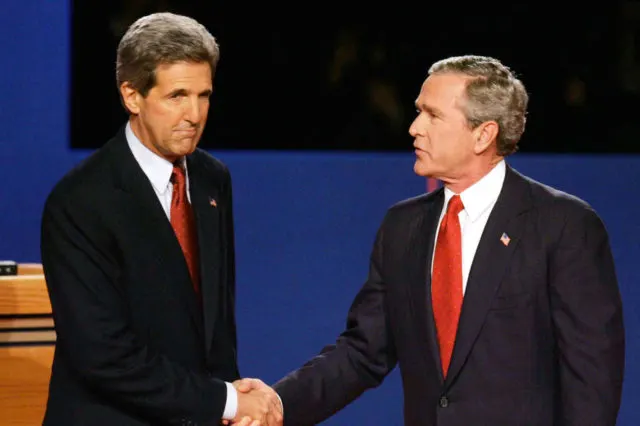| George W. Bush: | John Kerry: | Toss Up: |
2004 Election Results
President George W. Bush (R) won re-election against U.S. Senator John Kerry (D) on November 2, 2004.
Bush improved on his 270 electoral votes in 2000 by winning 286 electoral votes in 2004 to Kerry’s 251 electoral votes. The popular vote broke for Bush, who received 50.7% of the vote compared to 48.3% for Kerry. Bush and Kerry debated the country’s foreign policy in the wake of the 2001 attacks and the Iraq invasion and occupation.
The 2004 electoral map is above. Click on the states in the map to toggle them between Democrat, Republican and Tossup.
Primaries
Bush and Vice President Dick Cheney were renominated without meaningful opposition in the 2004 Republican primaries. The Democratic nominating process was more contentious as the party lacked a clear standard bearer for the first time since 1992. Nine Democratic candidates were active in the primaries with four candidates winning at least one primary.
Vermont Governor Howard Dean was an early leader for the Democratic nomination by criticizing Bush’s foreign policy. Dean led the field in fundraising through online engagement and a focus on individual donors. Dean also generated interest from progressive activists by advocating universal health coverage and middle-class tax cuts. This lead evaporated, however, when Dean placed third in the Iowa caucus behind Kerry and North Carolina Senator John Edwards.
Kerry’s campaign continued its momentum by winning New Hampshire and most Super Tuesday races. Following Super Tuesday, Edwards withdrew from the race and became the vice presidential nominee at the Democratic National Convention.
Central Issues
The Bush campaign promoted the president’s national security policies as a key argument for his re-election. In the wake of the September 11 attacks, Bush’s approval ratings reached 89% as the administration supported military action in Afghanistan to find terrorist Osama bin Laden. The October 2001 invasion was followed by the creation of a Department of Homeland Security and passage of the PATRIOT Act to prevent future attacks.
The post-September 11 popularity slowly declined as initial success in Afghanistan was followed by the problems of rebuilding the nation and fighting Taliban forces. By spring 2003, the Bush administration engaged in a second conflict with its invasion of Iraq. The March 2003 invasion led by the U.S. and Great Britain was based on arguments that Iraqi President Saddam Hussein was developing chemical weapons and supporting terrorists. Bush’s popularity spiked again following the invasion and again with Saddam Hussein’s capture in December 2003.
Democratic candidates criticized Bush and Cheney for mismanagement of the Afghanistan war and promoting faulty evidence to justify the Iraq War. Kerry voted for the 2003 authorization for use of force in Iraq in the Senate but criticized the invasion and concluded that not enough evidence existed to use force. Primary opponents and Bush criticized Kerry throughout the campaign for changing positions on American involvement in Iraq. Kerry countered that his vote for authorization did not preclude the use of diplomacy, sanctions, and coalition building to avoid war.
The Bush and Kerry campaigns also debated the effectiveness of Republican-supported tax cuts in 2001 and 2003. Bush argued that the cuts expedited emergence from a 2001 recession and generated economic growth. Kerry countered that the cuts were aimed at wealthy Americans and erased a budget surplus created under the Clinton administration.
Strategy
Bush and Cheney often criticized Kerry as disconnected from average voters given his wife’s wealth and the Democratic lean of his home state. Kerry and Edwards focused their criticisms on the administration’s handling of foreign policy and inability to strengthen the economy. Surrogates for the Bush campaign questioned Kerry’s claims about his Vietnam War record, while Kerry raised questions about Bush’s National Guard service during the war.

The final month of the campaign showed a close race for the presidency. Pew Research Center’s poll in early October found Bush ahead of Kerry 49% to 44%. The same poll one week from the election had Bush at 48% and Kerry at 45%. Both polls were within the margin of error, leaving doubt about who would win on November 2.
2000 Election Results
The solidity of Democratic and Republican voting coalitions meant that the race was decided in a handful of swing states. Both campaigns focused attention in Florida, Michigan, Ohio, Pennsylvania, and Wisconsin given narrow margins in recent elections. The Republican hold on the South, the Great Plains, and much of the West meant that Kerry needed to sweep the swing states. Bush won Florida and Ohio to lock up key votes in the Electoral College.
Bush’s re-election relied on winning enough white voters to offset Democratic advantages among non-white voters. Bush won 55% of white men and 48% of white women, which provided enough room to win the election given that 77% of all voters were white. Republicans were also able to win among voters older than 30 years old, which represented 83 percent of the vote.
